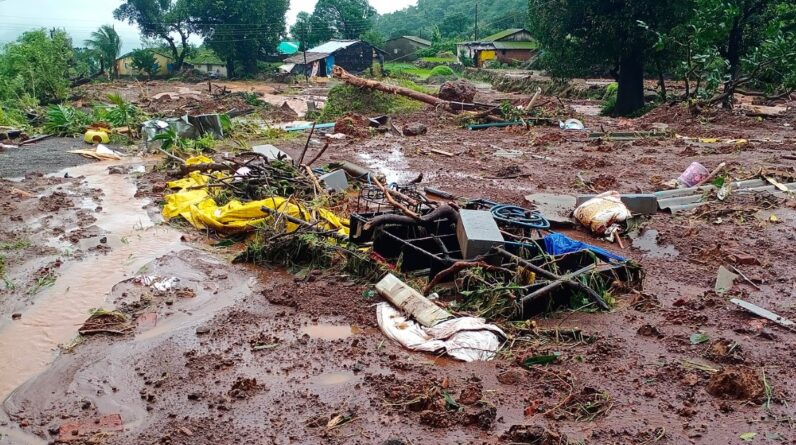
[ad_1]
Landslide during the floods in Patan block, Satara, Maharashtra, India in 2021.
Credit – वर्षा देशपांडे, CC SA 4.0.
Destructive flooding is happening around the globe, and these events have one thing in common: Storms forming in a warmer atmosphere.
Although terrible flooding in India, Japan, China, Turkiye, and the United States may seem to be distant and isolated events – they are not isolated, say atmospheric scientists, according to CTV News Canada.
Simply put, a warmer atmosphere means more extreme rainfall has become a reality. And additional warming is leading scientists to predict that it will only get worse.
Pollutants, especially carbon dioxide, and methane, are heating the atmosphere. Instead of allowing heat to radiate away from Earth into space, they hold onto it. Storms are forming in an atmosphere that is becoming warmer and wetter.
“Sixty-eight degrees Fahrenheit can hold twice as much water as 50 degrees Fahrenheit,” said Rodney Wynn, a meteorologist at the National Weather Service in Tampa Bay. “Warm air expands, and cool air contracts. You can think of it as a balloon – when it’s heated, the volume is going to get larger, so therefore it can hold more moisture.”
According to NASA, for every 1 degree Celsius, which equals 1.8 degrees Fahrenheit, the atmosphere warms, holding about seven percent more moisture. The average global temperature has increased by at least 1.1 degrees Celsius (1.9 degrees Fahrenheit) since 1880.
“When a thunderstorm develops, water vapor gets condensed into rain droplets and falls back down to the surface. So as these storms form in warmer environments that have more moisture in them, the rainfall increases,” explained Brian Soden, professor of atmospheric sciences at the University of Miami.

Soden cites Turkiye’s mountainous and scenic Black Sea coast, where heavy rains swelled rivers and damaged cities with flooding and landslides. At least 15 people were killed by flooding in another mountainous region in southwestern China.
“As the climate gets warmer we expect intense rain events to become more common, it’s a very robust prediction of climate models,” Soden added. “It’s not surprising to see these events happening, it’s what models have been predicting ever since day one.”
Gavin Schmidt, climatologist, and director of the NASA Goddard Institute for Space Studies, also points out that the regions being hit the hardest by climate change are not the ones that emit the largest amount of planet-warming pollutants.
“The bulk of the emissions have come from the industrial Western nations and the bulk of the impacts are happening in places that don’t have good infrastructure, that are less prepared for weather extremes and have no real ways to manage this,” said Schmidt.

Japan experiences the ‘heaviest rain ever’
Six people died and three others were missing after the “heaviest rain ever” triggered floods and landslides in southwest Japan. Residents in Kyushu, one of the country’s four main islands, were warned to stay alert for landslides.
The chief cabinet secretary, Hirokazu Matsuno, said up to six people were thought to have died as a result of heavy rain that caused rivers to burst their banks and disrupted to bullet train services, as well as cutting off roads and water supplies.
“This is the heaviest rain ever experienced” in the region, said Satoshi Sugimoto, a meteorological agency official, reports The Guardian. “The situation is such that lives are in danger and their safety must be secured.”

India hit with flooding and landslides
At least 49 people have died since the weekend amid unusually heavy downpours that have pummeled the northern part of the country and caused widespread damage.
The hardest hit was the Himalayan state of Himachal Pradesh, which received more than 10 times its average rainfall for this time of year. The death toll there stood at 30 as of Monday evening, according to the local police.
Extreme weather patterns, including record heat waves and heavy floods in the monsoon season, have become more frequent, putting extra hardship on farmers who complain of the devastating effect on crops as the rains have become more unpredictable and damaging.
R.K. Jenamani, who works for the India Meteorological Department in New Delhi, said, “The rainfall is several times more than normal. For example, in Himachal Pradesh, the normal rainfall would have been around eight millimeters (less than half an inch), but it was 103.4 millimeters (about four inches) on Sunday.”
Some of the heaviest rainfall in decades also struck the Delhi region, according to the India Meteorological Department. The rains flooded homes and streets, killing at least three people, Delhi fire department officials said.
[ad_2]
Source link






